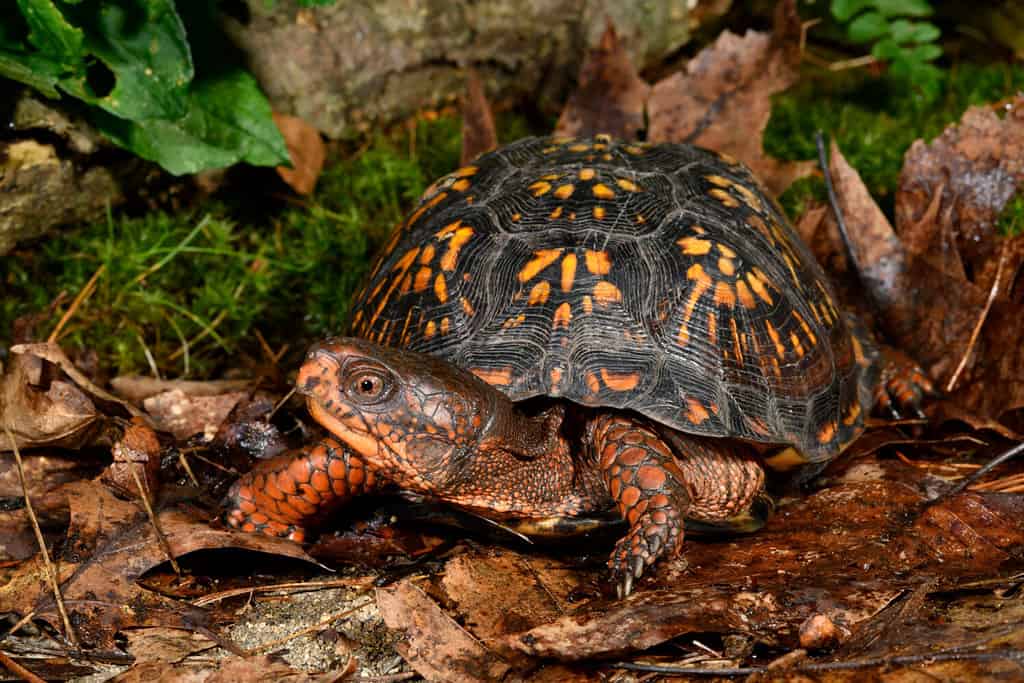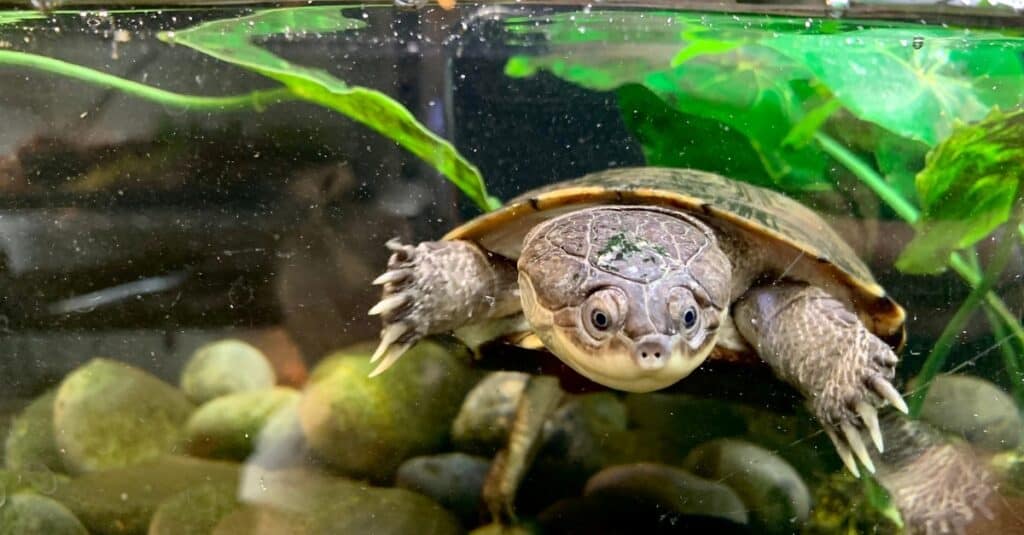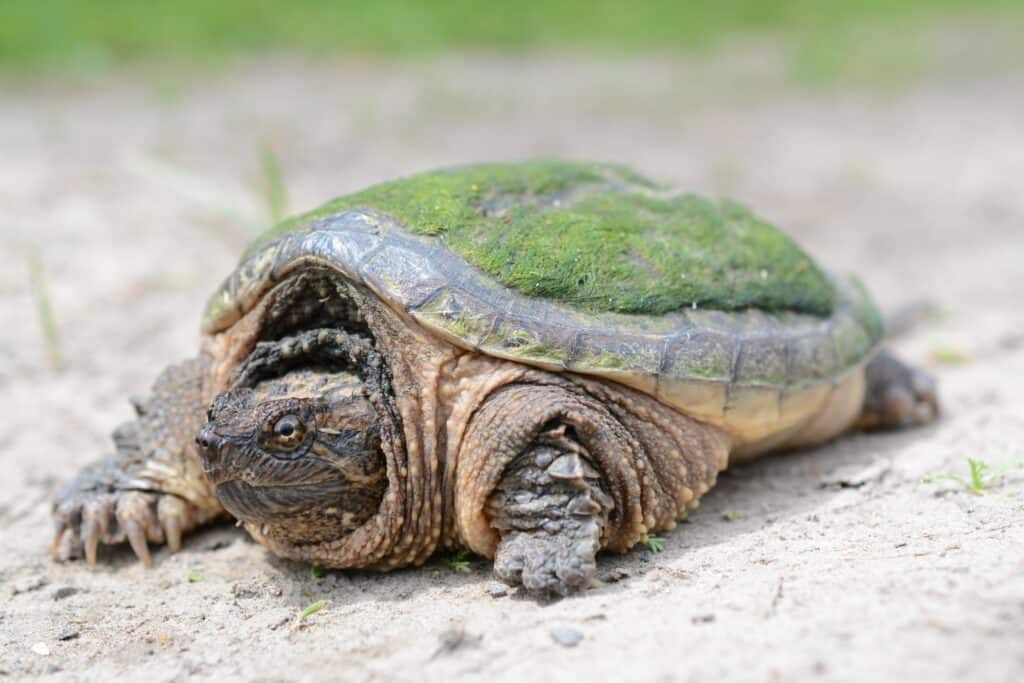Turtles are enchanting reptiles that have been captivating hearts for generations. From tiny red-eared sliders to majestic aquatic turtles, there’s a turtle species for everyone. Whether you’re a beginner or a seasoned turtle enthusiast, you’re sure to find a shelled companion that suits your lifestyle.

In this article, we’ll dive into the diverse universe of pet turtle species, each with its unique charm and characteristics.
1. Red-Eared Slider

The most distinctive characteristic of the red-eared slider is the bright, red stripe behind the eyes.
©iStock.com/PaulReevesPhotography
The red-eared slider is a popular and distinctive freshwater turtle commonly kept as a pet. Known for its vibrant appearance, it has a glossy, smooth shell with distinct red markings on either side of its head, near the eyes, which give it its name. Its body is predominantly olive to brownish-green with yellow stripes, and it typically grows to a length of eight to 12 inches.
As a pet, red-eared sliders require a well-maintained aquatic environment. A spacious tank or pond with a basking area is essential. The water temperature should be kept around 75-80 degrees F with the help of a heater, while a UVB lamp is necessary to provide the necessary UV rays for their health. A strong filtration system is vital to maintain water quality.
Feeding red-eared sliders is relatively uncomplicated, as they are omnivorous. Their diet includes a variety of aquatic plants, insects, small fish, and commercial turtle pellets. It’s crucial to offer a balanced diet to ensure their health and growth.
Maintaining good hygiene is crucial for their well-being. Regularly cleaning the tank, removing uneaten food, and providing clean, dechlorinated water are essential to prevent health issues.
Additionally, red-eared sliders have a long lifespan, often lasting for 20 to 30 years or more. Therefore, potential owners should be prepared for a long-term commitment. It’s also essential to check local regulations, as they might govern the ownership of red-eared sliders, especially in some regions where they are considered invasive species.
2. Eastern Box Turtle

Eastern box turtles need humidity levels up to 80%.
©Breck P. Kent/Shutterstock.com
The eastern box turtle is a captivating reptile native to the eastern United States. Its distinctive appearance and unique personality make it a sought-after choice as a pet among reptile enthusiasts.
Eastern box turtles are relatively small, with a shell that measures around four to six inches in length. Their shell is domed and characterized by intricate patterns of yellow, orange, and brown markings, often resembling a topographical map. The coloration varies among individuals, which makes each turtle unique. Their legs are sturdy and well-suited for terrestrial life, and their head is marked by bright orange or red eyes.
Eastern Box Turtles as Pets
When considering a box turtle as a pet, it’s essential to understand their specific care requirements. These turtles are terrestrial, meaning they spend most of their time on land, but they also need access to fresh water for drinking and soaking. A spacious outdoor enclosure with a secure barrier is ideal for replicating their natural habitat, as it allows them to forage for food and bask in the sun. The enclosure should include hiding spots and a shallow water dish.
Feeding an eastern box turtle involves offering a varied diet. They are omnivorous, so their menu should include a mix of vegetables, fruits, insects, worms, and even the occasional small vertebrate like a pinky mouse. It’s crucial to provide a calcium supplement to maintain their shell health.
For their well-being, it’s crucial to keep the right temperature and humidity levels. These turtles demand humidity levels of 60 to 80% and may flourish at temperatures between 70 and 85 degrees Fahrenheit. It is crucial to give them a sufficient substrate and a place to retreat from severe weather.
Since they are not cold-tolerant, a heated indoor habitat during the winter may be required in colder climates. To keep an eye on their health and make sure they are not suffering from respiratory infections—which they might be prone to if kept in wet or chilly conditions—regular veterinarian check-ups are advised.
3. Wood Turtle

Wood turtles require temperatures between 70 and 80 degrees F.
©Brandt Bolding/Shutterstock.com
The wood turtle, a charming and unique species, is native to the northeastern United States and parts of Canada. Recognizable by its striking appearance and engaging behavior, it is occasionally kept as a pet by reptile enthusiasts.
Wood turtles have a distinctive appearance with a dark, domed shell, typically measuring around 6 to 8 inches in length. Their shells display a mosaic-like pattern of concentric rings and radiating lines, often resembling a piece of artwork. These animals’ limbs are sturdy and adapted for terrestrial living, and their coloration varies from brown to dark olive. Their head features a distinct yellowish patch behind each eye, and they have bright orange or red eyes.
Caring for a wood turtle as a pet requires careful attention to their natural habitat and behaviors. These turtles thrive in environments with a mix of woodlands and freshwater streams, so replicating such conditions is essential.
Providing a spacious outdoor enclosure with access to clean, flowing water is crucial. The enclosure should include hiding spots, a basking area, and plenty of vegetation to mimic their natural habitat. Wood turtles are omnivorous, enjoying a diet of insects, earthworms, snails, various vegetation, and fruits. It’s essential to offer a well-balanced diet to meet their nutritional needs.
Maintaining the appropriate temperature and humidity levels is vital for their well-being. These turtles prefer cooler temperatures, typically between 70 to 80 degrees F, but they require a humid environment with a humidity level of around 60 to 80%. A shelter within their enclosure can provide a retreat from extreme weather conditions.
Regular veterinary check-ups are recommended to monitor their health, especially to prevent respiratory issues, which can occur if they are kept in damp or cold conditions.
4. Musk Turtle

The musk turtle is best suited for pet owners who have worked with turtles before.
©iStock.com/AntonyMoran
Native to North America, the musk turtle is a small yet intriguing species of reptile. This turtle is renowned for its striking look and pungent scent. Although it’s less popular as a pet than some other turtles, it has charm for people who value its eccentric temperament.
Musk turtles are relatively small, typically measuring around three to five inches in length. They have a smooth, dark-colored shell with a low dome shape. Their skin is dark and usually adorned with a series of yellowish or white stripes on each side, which may vary among individuals. These turtles also have webbed feet and a small, pointed head. Their most distinctive feature is the musk gland located near their cloaca, which emits a strong odor when they feel threatened or stressed.
Musk Turtles as Pets
Caring for a musk turtle as a pet requires careful attention to their habitat and specific needs. A proper enclosure should be set up to mimic their natural environment. A 20 to 40-gallon tank is suitable for one or two musk turtles. The tank should include a basking area, as well as a water area deep enough for swimming. Musk turtles are highly aquatic, so maintaining clean water is essential. A submersible water heater and filter are important to regulate water temperature and quality.
Being predominantly carnivorous, musk turtles eat tiny fish, aquatic invertebrates, and even vegetation. To ensure that their nutritional demands are addressed, it is essential to offer a diversified diet. They may be fed a variety of live and frozen items, such as brine shrimp, bloodworms, and processed turtle pellets.
Maintaining the proper water temperature in the tank is essential. Musk turtles prefer a water temperature between 70-78 degrees F and a basking area with a temperature around 85 degrees F. Proper lighting, including a UVB lamp, helps turtles metabolize calcium and maintain overall health.
5. African Sideneck Turtle

African side-neck turtles are known for their long necks.
©Megan Czarnocki/Shutterstock.com
The African side neck turtle is a reptile species native to the freshwater habitats of central and western Africa. Recognized for its distinctive appearance and intriguing behavior, it is a popular choice among reptile enthusiasts as a pet.
African side-neck turtles have a unique physical appearance. They normally reach a size of six to ten inches, which is considered tiny among turtles. Their relatively flat, extended carapace, or shell, is colored in different tones of brown and black. A skin tone that contrasts this shell well is reddish-brown to dark brown with light spots or stripes. Their head is relatively small and features a unique characteristic: they have necks that can’t be fully retracted into their shell, which they tuck sideways beneath it. This “side neck” adaptation is distinctive to this species.
Caring for an African Sideneck Turtle
Caring for an African side-neck turtle as a pet involves creating a suitable aquatic habitat and meeting their specific needs. A spacious tank with a minimum of 40 to 55 gallons is recommended for one adult turtle. The tank should have clean, dechlorinated water in both swimming and basking areas. A submersible water heater and filter are essential for maintaining water temperature (around 75 to 80 degrees F) and quality.
Proper lighting is important for African side-neck turtles. They require access to UVB lighting to aid in calcium metabolism and overall health. A basking area with a heat lamp is also necessary to create a temperature gradient in the tank, allowing them to regulate their body temperature effectively.
Regular tank cleaning and water quality maintenance are vital to prevent health issues, as poor water conditions can lead to skin and shell problems. It’s also important to provide a hiding spot to reduce stress and minimize handling, as these turtles may become easily stressed when picked up.
6. Painted Turtle

Painted turtles are excellent beginner pet turtles.
©Danita Delimont/Shutterstock.com
We can’t have a list of pet turtles without mentioning the painted turtle! The painted turtle is a charming and widely recognized freshwater turtle species native to North America. Its striking appearance and ease of care have made it a popular choice among reptile enthusiasts as a pet.
Painted turtles exhibit a distinctive and eye-catching appearance. They typically measure between four to 10 inches in length, with females being slightly larger than males. The most prominent feature of their appearance is their colorful shell, or carapace, which is typically dark green to black and adorned with vibrant red or yellow markings. These markings can vary among individuals, giving each painted turtle a unique and attractive appearance. Their skin is also colorful, often featuring bright red or orange markings and their legs are adorned with yellow stripes.
Painted Turtle Care
Caring for a painted turtle as a pet involves providing a suitable aquatic habitat and meeting their specific needs. A spacious tank with a minimum of 40 gallons is recommended for one adult turtle, with larger tanks being better for multiple turtles. The tank should have clean, dechlorinated water and include both swimming and basking areas. A submersible water heater and filter are essential for maintaining water temperature (around 75-80 degrees F) and quality.
Proper lighting is crucial for painted turtles. They require access to UVB lighting to help them metabolize calcium and maintain strong shells and bones. A basking area with a heat lamp is also necessary to provide a temperature gradient in the tank, allowing them to regulate their body temperature effectively.
Regular tank cleaning and water quality maintenance are essential to prevent health issues. Poor water conditions can lead to skin and shell problems. Providing a hiding spot in the tank can reduce stress, as painted turtles may become easily stressed when handled.
7. Common Snapping Turtle

Snapping turtles are best for advanced reptile owners.
©Trevor Meunier/Shutterstock.com
The common snapping turtle is a distinct and formidable reptile species found throughout North America. Known for its rugged appearance and powerful jaws, it is not a common choice as a pet due to its size and demanding care requirements.
Common snapping turtles are among the largest freshwater turtles, with adult specimens often reaching lengths of eight to 18 inches or more. They have a robust and muscular body covered with dark, rough, and textured skin, often featuring algae or plant growth. Their shell, or carapace, is dark brown to black and has serrated edges, which add to their prehistoric look. Their legs are strong, ending in webbed feet equipped for both swimming and digging.
Common Snapping Turtles as Advanced Pets
Caring for a common snapping turtle as a pet is a complex task due to their size, strength, and specific needs. Since they are very aquatic and need access to clean water and a dry basking place, a roomy and safe outside cage is required to simulate their natural environment. A water heater and filter should be installed in the enclosure to preserve the water’s purity and temperature, which should be between 70 and 80 degrees Fahrenheit.
Being opportunistic predators, common snapping turtles can be difficult to feed. Fish, amphibians, insects, crustaceans, small mammals, and amphibians all make up its food. It is essential to provide a diversified diet for their general health and well-being. It’s crucial to remember that they have strong jaws and should be fed carefully because they can bite viciously when eating.
Regular cleaning of the enclosure and monitoring water quality is vital to prevent health issues. Snapping turtles can be prone to skin and shell problems if exposed to poor water conditions.
It’s important to emphasize that common snapping turtles can be challenging to handle and may not make suitable pets for everyone. They have a powerful bite and can become stressed when approached. In some regions, they are also protected by law, and owning one may require permits or licenses.
Summary of the Absolute Best Types of Pet Turtles: The Complete List
| # | Turtle | Expertise |
|---|---|---|
| 1 | Red-Eared Slider | Beginner |
| 2 | Eastern Box Turtle | Intermediate |
| 3 | Wood Turtle | Advanced |
| 4 | Musk Turtle | Intermediate |
| 5 | African Sideneck Turtle | intermediate |
| 6 | Painted Turtle | Beginner |
| 7 | Common Snapping Turtle | Advanced |
The photo featured at the top of this post is © iStock.com/Funkuokando Nin
Thank you for reading! Have some feedback for us? Contact the AZ Animals editorial team.






